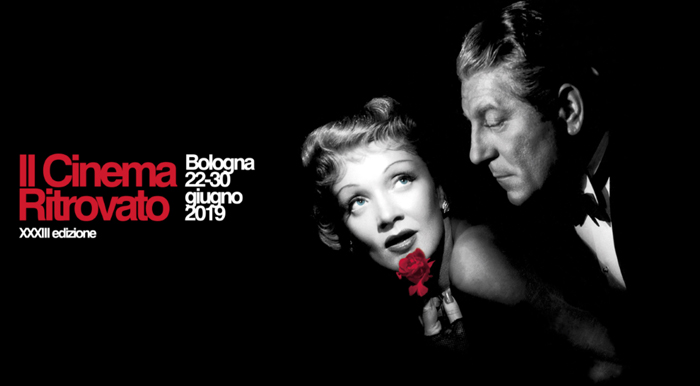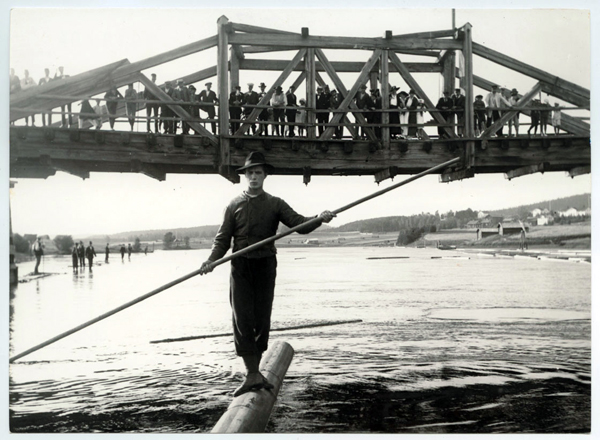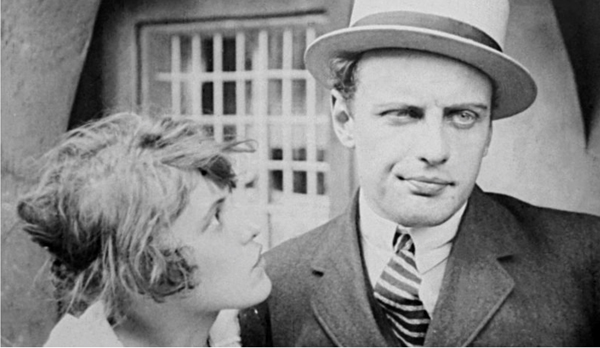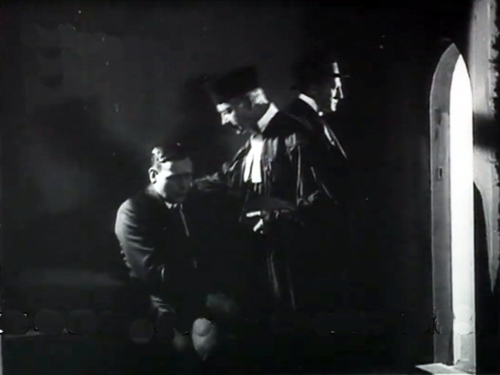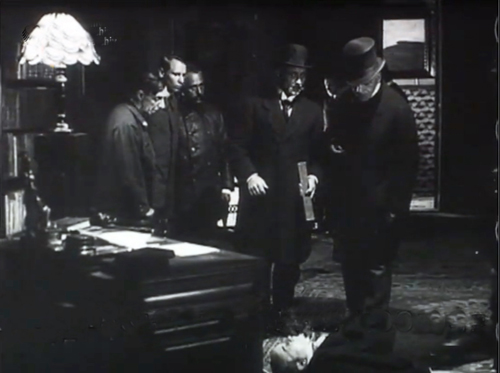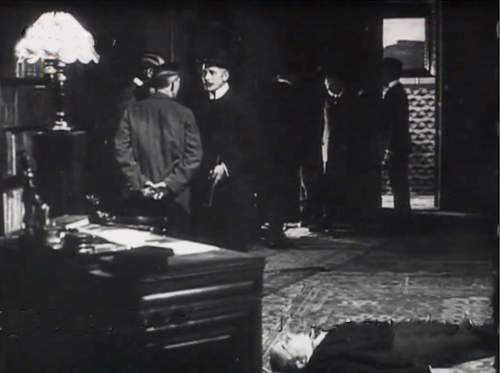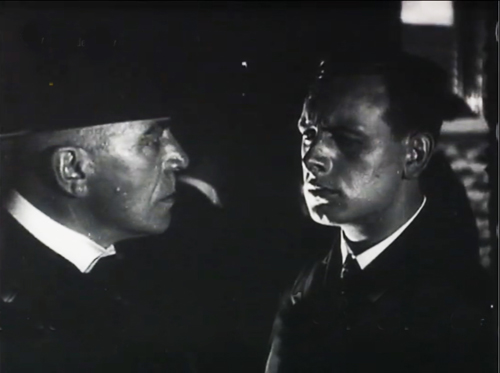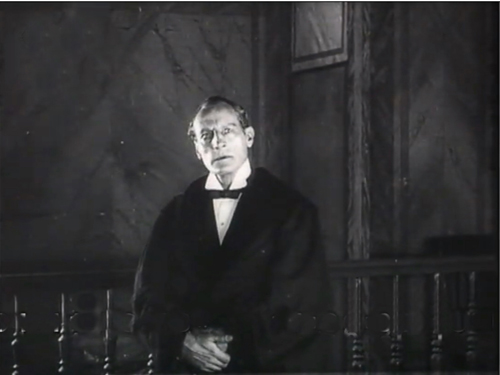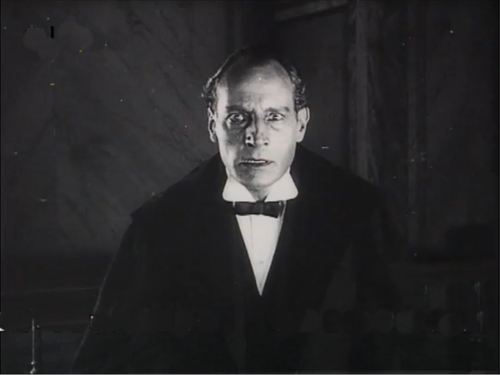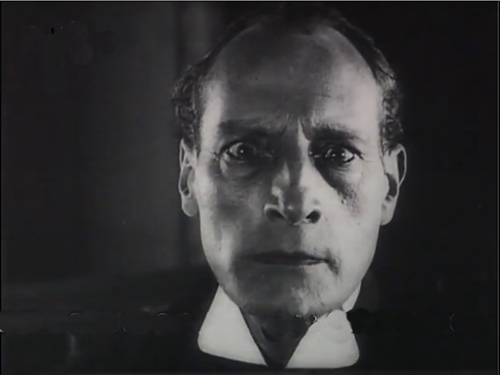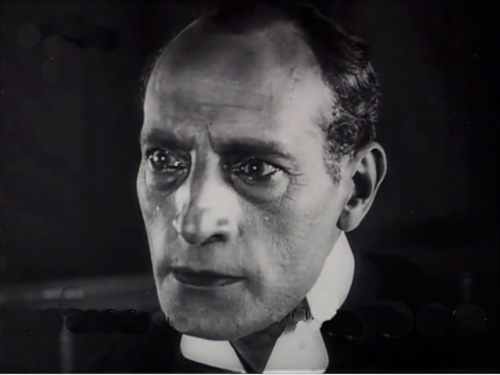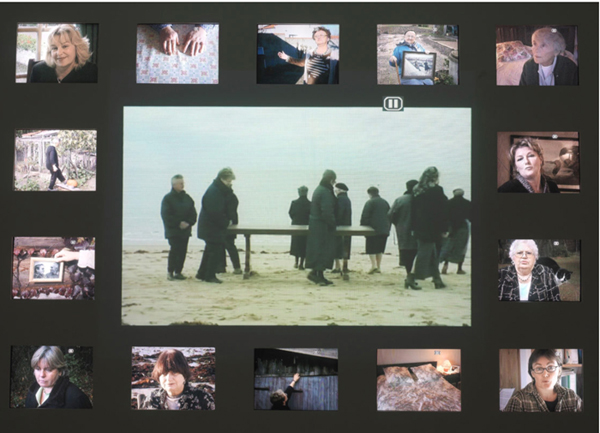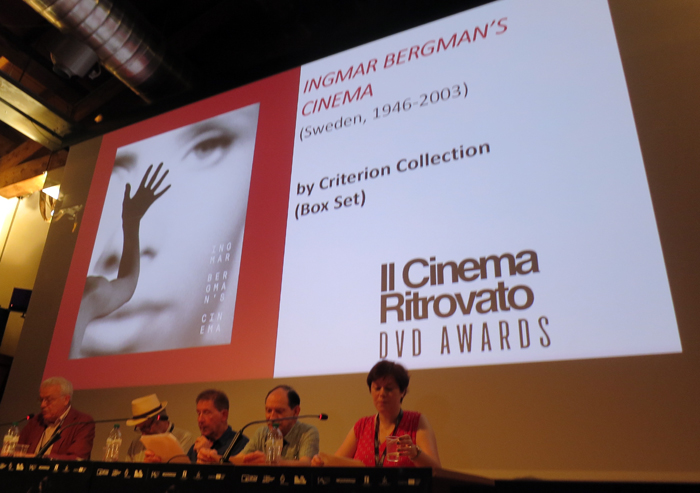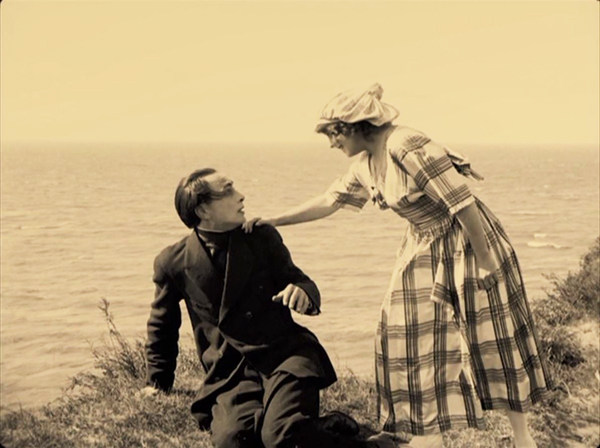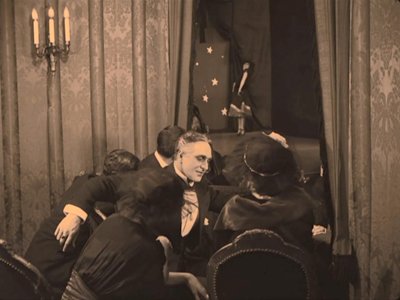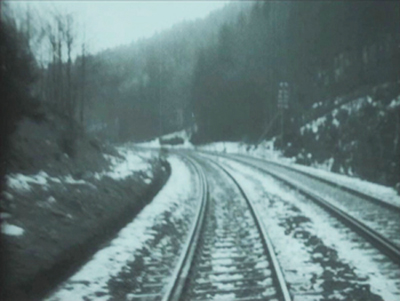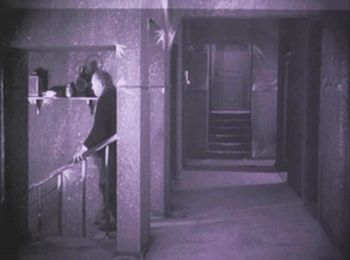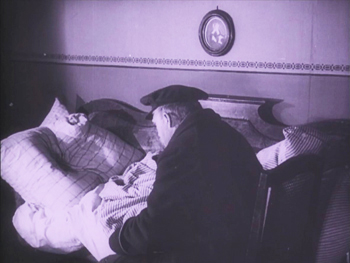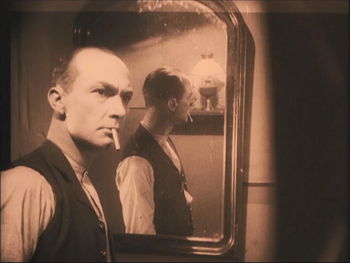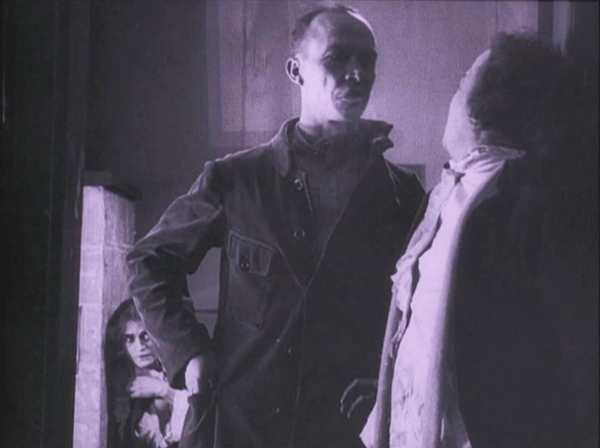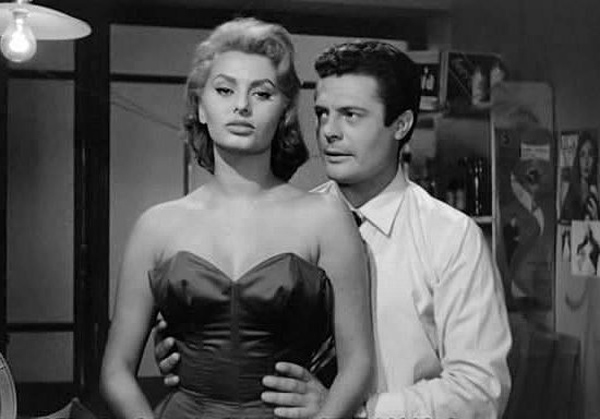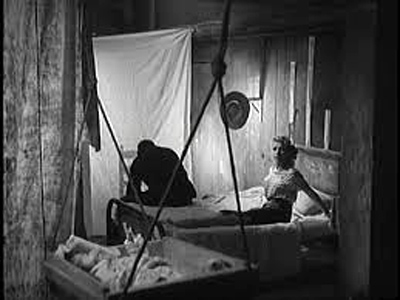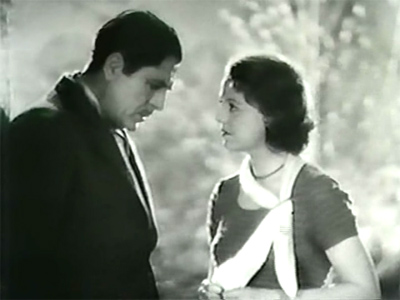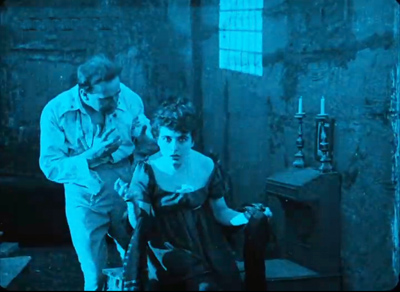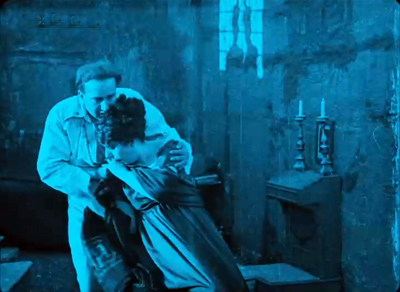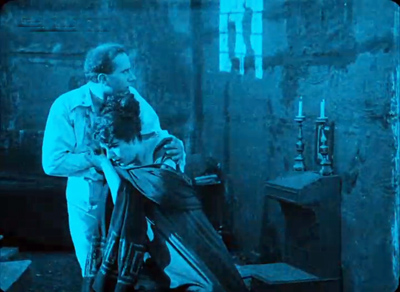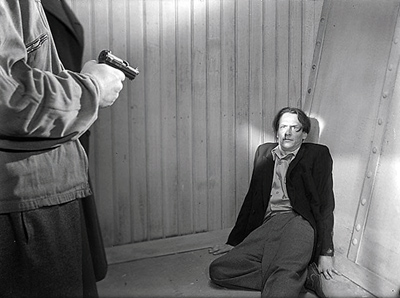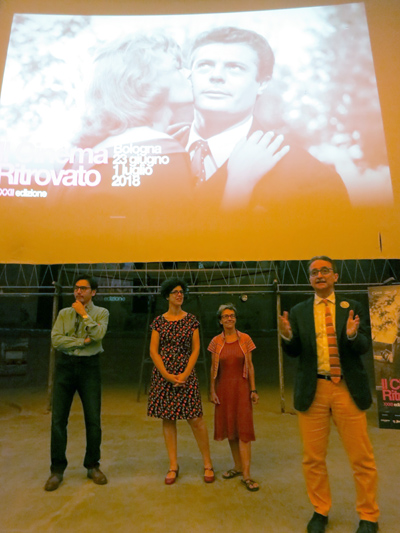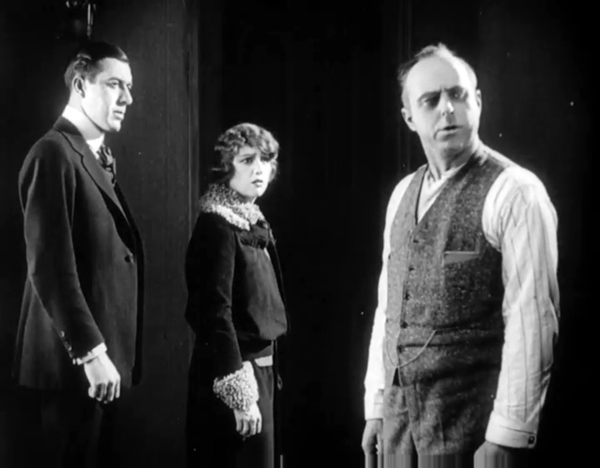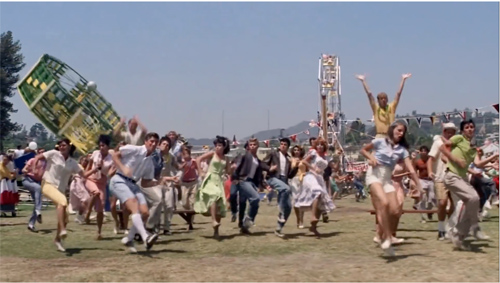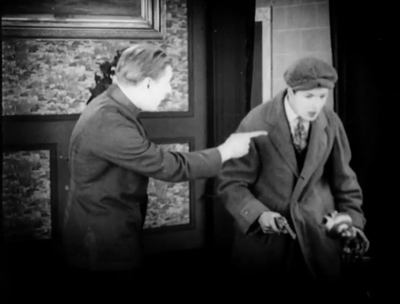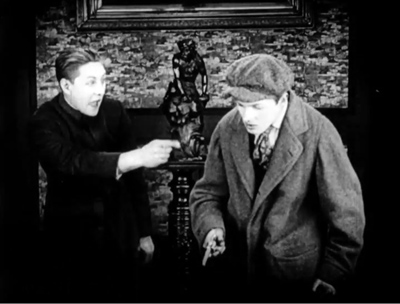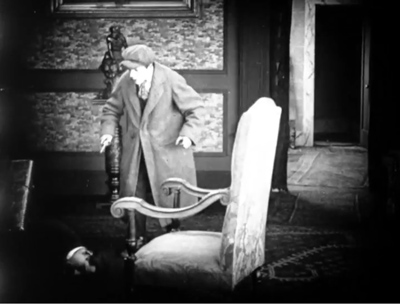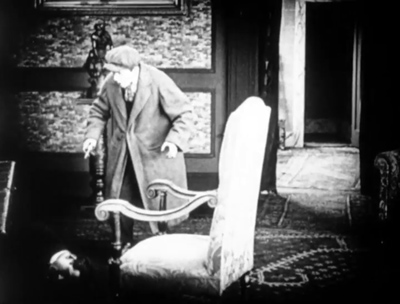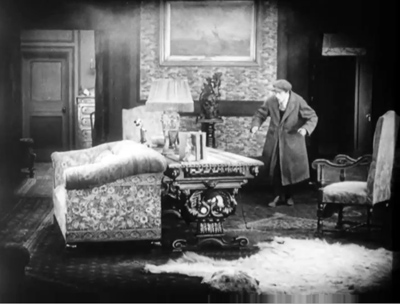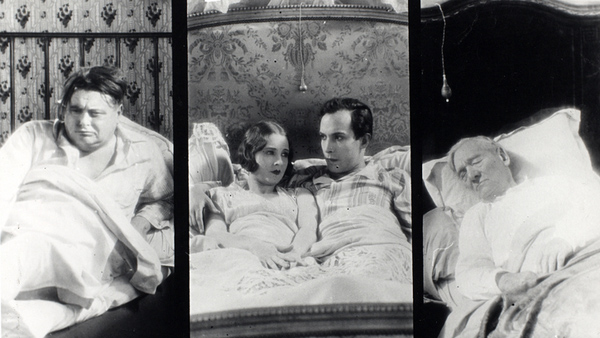Archive for the '1910s cinema' Category
A hundred years ago, and less, at Cinema Ritrovato ’19
DB here:
Hundreds of films, thousands of passholders, sweltering heat (105 degrees Fahrenheit on Thursday). Dazzling tributes to Fox films, Youssef Chahine, Eduardo De Filippo, Henry King, Felix Feist, silent star Musidora, sound star Jean Gabin, and other themes. Many filmmakers from Africa, South Korea, and Europe, as well as master classes with Francis Ford Coppola and Jane Campion.
Yes, Cinema Ritrovato is on steroids this year.
And as we always say: There are so many tough, indeed impossible, choices. Kristin has been faithfully following the African series, while I’ve hopped between restored and rediscovered Hollywood classics and the films from 1919. Today I’ll report a bit on the latter, with an addendum on a major filmmaker’s ave atque vale.
1919 bounty
Song of the Scarlet Flower (1919). Production still.
By the end of the 1910s, the feature-length format had become well-established, and a bevy of directors in Europe and America were launching their careers. Abel Gance, Victor Sjöström, Mauritz Stiller, John Ford, Raoul Walsh, Cecil B. DeMille, Lois Weber, Charlie Chaplin, Douglas Fairbanks, William S. Hart, Mary Pickford, and many other figures had already made impressive work. 1919 brought us some outstanding titles. There was von Stroheim’s Blind Husbands, Griffith’s Broken Blossoms and True Heart Susie, Lubitsch’s Madame DuBarry, along with the lesser-known Victory of Maurice Tourneur, the first part of Sjöström’s Sons of Ingmar, and the overbearing, delirious Nerven of Robert Reinert.
Bologna showed none of these. Its massive 1919 lineup featured some classics in restorations, notably Capellani’s The Red Lantern (starring Nazimova), Dreyer’s debut The President, and Stiller’s Herr Arne’s Treasure. As a sidebar there was the 1919 Italian serial I Topi Grigi, a fun sub-Feuillade exercise in crooks and chases with some nifty shots. And there were a great many fragments and short films from that year, including a Hungarian entry by Mihály (Michael) Kertész (Curtiz).
Less known than Stiller’s official classics is The Song of the Scarlet Flower, a wonderful open-air drama about a young farmer’s wanderings and his heart-rending romances with three women. In a new digital version, it emerged as one of the most sheerly beautiful films I saw at Bologna. The central action sequence, in which the hero dares to ride a log through rapids to the very edge of a waterfall, gained even greater tension thanks to the swelling orchestral score by Armas Järnefelt–the only original score to be preserved for a Swedish silent.
1919, German style
Der Mädchenhirt (The Pimp, 1919). Production still.
Then there were two remarkable German films unknown to me, both by directors better known for later work. Der Mädchenhirt (The Pimp) was by Karl Grune, most famous for The Street (Die Strasse, 1923). The plot follows a shiftless young man who casually becomes a pimp and pulls women into prostitution. Introducing the film, Karl Wratschko pointed out that many Weimar films warned of sexual misbehavior, and certainly the young hero of this film gets ample punishment for his sins.
Stylistically, Der Mädchenhirt was typical of much European cinema of the late ‘teens, when the tableau style, which promoted intricate staging with few analytical cuts, was losing force. Grune mostly handles action in ensemble shots broken up by axial cuts to closer views. If German filmmakers weren’t quite as editing-prone as other European directors, that may be because they didn’t have access to American models. Not until January 1920 were Hollywood films of the war years imported into Germany.
Another film carried this moderate continuity style to an intriguing extreme. Tötet nicht mehr! (Kill No More!) framed a plea against capital punishment within a family drama. Sebald, the son of a by-the-book prosecutor, falls in love with the daughter of a former prisoner. When Sebald is cast out by his father, the couple take up a theatrical career playing Pierrot and Colombine. But then Sebald blocks the theatre director from seducing his wife, so the director blackballs them and they can’t get work in other shows. Visiting the director, Sebald quarrels with the man and kills him. He’s arrested, tried, and sentenced to death.
Tötet nicht mehr! displays some remarkable visual qualities. Cross-lighting in the climactic prison scenes sculpts Sebald, the priest, and the lawyer Landt in a bold variety of ways.
Director Lupu Pick (Sylvester, 1924) uses this dramatic lighting to enhance the tableau-plus-axial-cut approach. The police are examining the crime scene and questioning Sebald. A depth composition gives us the corpse in the lower foreground, the detectives in the middle ground, and way in the back, the barely-visible face of Sebald perched between the shoulders of the two central men.
One detective walks to the distant background to question Sebald. Anybody else would have staged this bit of action in the better-lit zone on the left, where a detective talks with his colleagues. Instead, far back, a single pencil-line of light picks out the edge of Sebald’s face and body.
An axial cut-in presents a tight two-shot of the cop and Sebald–again, made stark and tense by the lighting.
The plot of Tötet nicht mehr! is a generational one, starting with the tragedies befalling the woman’s father. These scenes introduce the sympathetic lawyer Landt, who tries to help the family throughout its troubles. Landt becomes the vehicle of the film’s message against capital punishment, which gets full airing in the boy’s trial.
In the films of the 1910s, courtroom scenes tend to be more heavily and freely edited than others. This is largely because of the need to cut among judges, jury, witnesses testifying, lawyers pontificating, and the onlookers. Pick exploits the situation with dozens of shots of participants. We also get optical point-of-view shots showing Sebald awaiting the jury’s verdict by staring at the doorknob of the jury room. There’s even a “lying flashback,” which dramatizes the prosecutor’s inaccurate reconstruction of the quarrel that led to the crime.
Most impressive, I think, is the pictorial progression in Landt’s impassioned plea to the jury to let Sebald escape execution. Among many reaction shots and reestablishing framings, Landt is rendered in increasingly close shots as he addresses the judges and the jury–and us.
The textural lighting and the ruthless elimination of the background reminded me of the trial scene of André Antoine’s Le Coupable of 1917, run at an earlier installment of Ritrovato.
There were plenty of other 1919 films on display, several of which I have yet to see. But this should give you an indication of the service that Cinema Ritrovato continues to render to the cause of understanding film history.
Not so long ago
The Widows of Noirmoutier (2006).
Film history close to our time was the subject of Varda par Agnès, the filmmaker’s last statement on her career. Prepared during her final years of life and produced by her daughter Rosalie Varda, it’s a poignant and revealing account of what mattered to her in her work. It showed Varda’s wry, playful humor and her commitment to treating social issues in intimate human terms. It’s a body of cinema that grows ever more important each year.
Varda par Agnès also showed her characteristic sensitivity to overall form. It’s framed by bits of her talking to audiences in master classes, so she becomes the narrator. Some stretches are chronological, going film by film, but just as often the links are associational. The women of Black Panthers (1968) remind her of the abortion activists of One Sings, the Other Doesn’t (1977). That’s about the friendship of two women, which suggests by contrast a film about a woman alone, Vagabond (1985). The beach of Vagabond summons up the plenitude of Le Bonheur (1965). And so on.
This might seem rambling, but it’s not. Varda explains that she often conceives her films with a strict structure–the strung-together tracking shots of Vagabond, the tight time frame and spatial coordinates of Cleo from 5 to 7 (1962). Varda par Agnès splits about halfway through, flashing back to Varda’s early still photography and adroitly linking that to her emergence as a “visual artist.”
She began mounting expositions like L’Îl et Elle, which housed cinema cabins (big transparent cubes made of ribbons of 35mm film) and Widows of Noirmoutier. Around a central image of collective grief, small screens show women sharing the everyday details of life without a partner. In just this clip, it’s almost unbearably touching. Apart from the resonance with Varda’s devotion to Jacques Demy, I was reminded of Chekhov’s line: “If you’re afraid of loneliness, don’t get married.”
We’ve been so busy with films, and queueing for films, that we’ve had little time to blog about our visit. Later entries will have to come after we’ve left Cinema Ritrovato.
Thanks as usual to the Cinema Ritrovato Directors: Cecilia Cenciarelli, Gian Luca Farinelli, Ehsan Khoshbakht, Marianne Lewinsky, and their colleagues. Special thanks to Guy Borlée, the Festival Coordinator.
The complete score for Song of the Scarlet Flower is available on CD and streaming.
For Varda’s last visit to Cinema Ritrovato, go here. We discuss Varda’s career and Kelley Conway’s in-depth study of it here. See also Kelley on Varda at Cannes. A forthcoming installment of our Criterion Channel series is devoted to Vagabond.
For more on the stylistics of 1910s films, see the category Tableau Staging. I discuss The President in the Danish Film Institute essay, “The Dreyer Generation.”
The Criterion Collection’s magnificent Bergman collection wins Best Boxed Set at the annual DVD awards, Cinema Ritrovato 2019. Congratulations to producer Abbey Lustgarten and all her colleagues!
Two essential German silent classics from Edition Filmmuseum
Der Gang in die Nacht (1921).
Kristin here:
Back in 2016, the Munich Film Archive gave us a preview of the restored version of F. W. Murnau’s earliest surviving film, Der Gang in die Nacht (1921). The print was splendid, and David posted an entry in which he analyzed the film’s style and situated it in the context of German cinema in the early post-World War I years. He tied the film to the tableau style that developed in much of the world outside the USA during the 1910s and which began to adjust to Hollywood norms of continuity editing just when Murnau was making films like Der Gang in die Nacht.
In that entry he used several frames from the restoration, and a glance over it will show its spectacular visual quality. I won’t spend much time on that film here, since David covered it so thoroughly. He wrote, “We can hope that the film will soon appear on DVD. Remember DVDs?” He and I certainly do. The Edition Filmmuseum obviously does as well. They continue to release their restorations and collections of more recent experimental films solely on DVD. Maybe Blu-rays are simply too expensive to produce, or perhaps the staff there consider Blu-rays a passing fad, like talkies. At any rate, this DVD release looks great (see above). it can easily be ordered from the Edition Filmmuseum’s shop (English page).
Apart from the tableau staging and the proto-continuity cut-ins that David discusses, there are some impressive depth shots–involving, as often happens in 1910s films, spectators in a theater box with the stage in the distance.
The film was restored from the original camera negative, though negatives were not edited in the final form of the film. By studying Murnau’s shooting script and restoration work previously done by Enno Patalas, the team were able to reconstruct the films’s editing and intertitles. The tinting and toning are based on the conventions of the period and are thoroughly plausible. David’s remarks in his earlier post are condensed slightly into this still applicable summary quoted in Stefan Drössler’s notes on the film:
The Munich Film Museum’s team has created one of the most beautiful editions of a silent film I’ve ever seen. You look at these shots and realize that most versions of silent films are deeply unfaithful to what early audiences saw. In those days, the camera negative was usually the printing negative, so what was recorded got onto the screen. The new Munich restoration allows you to see everything in the frame, with a marvelous translucence and density of detail. Forget High Frame Rate: This is hypnotic, immersive cinema.
The DVD lives up to that description.
A 1921 double feature
Without much fanfare, this release also contains another major classic of 1921, Scherben (“Shattered” or more literally “Fragments”). Its director, Lupu Pick, is probably best known today from his performance as the tragic Japanese spy, Dr. Masimoto, in Fritz Lang’s Spione (1928). He was, however, a prolific director from 1918 to 1931. (His acting career lasted from 1910 to 1928.) Many of his films are apparently lost, though I have seen two: Mr. Wu (1918) and Das Panzergewölbe (1924), both good but conventional films.
As a director, however, he is best known for making two of the main films in the brief vogue for Kammerspiele: Scherben and Sylvester, or New Year’s Eve (1923). These two films were scripted by Carl Mayer, who, as Anton Kaes points out in the accompanying booklet, wrote all the German Kammerspiele films: Hintertreppe (1921, dir. Leopold Jessner), Sylvester, and Der letzte Mann (1924, dir. Murnau). One might add Carl Theodor Dreyer’s Michael (1924), shot in Germany and scripted by Thea von Harbau.
Mayer was all in favor of films with no intertitles–though in practice that meant almost none. Der letzte Mann is one such, with an expository title introducing the sarcastic happy ending that Mayer was forced to add. Scherben is another. Near the end there is a single dialogue title. Moreover, Scherben’s subtitle is Ein deutsches Filmkammerspiel: Drama in fünf Tage. The five days are divided into the five reels of the film, and each is introduced by an expository title. There are a few letters and other texts that convey vital information, but overall the action is presented pictorially.
Scherben might be said to represent the slow cinema of its day. Its remarkable and lengthy opening shot is filmed from the front of a slowly moving train, simply showing progress along a track in a snowy landscape (above).
The main character (played by Werner Krauss, famous as Dr. Caligari) is a linesman, living with his wife and daughter in an isolated house. Their stultifying daily routine is gradually set up during the early scenes. Drama is introduced when a railroad inspector comes to visit, staying with the family. He and the daughter are immediately attracted to each other, spending a night together. The wife discovers this, staggers out into the snow to pray at a local shrine, and freezes to death. The tragedy deepens from there.
The film proceeds at the notoriously languid pace of German art films of the period. Pick injects stylistic flourishes derived from trends of the period. For some reason, the hallway of the family’s house has little Expressionistic painted highlights dotted around it.
Werner Krauss often acts “with his back,” well before Emil Jannings was praised for doing so in the framing prison scenes of E. A. Dupont’s Variety (1925.)
Pick calls upon the 1910s obsession with mirrors when the inspector reacts to accusations that he has seduced the linesman’s daughter.
Pick also evokes the depth staging of the tableau style, with small areas of the screen glimpsed in the background, most notably in the scene where the mother discovers the lovers together. (See below.)
The print is not as spectacular as that of Der Gang in die Nacht, having been reconstructed from prints in the Gosfilmofond archive in Moscow and the Bundesarchiv in Berlin without extensive digital restoration. Still, we should be glad to have this milestone film available. Taken together, the two films make a welcome addition to the number of German classics available for home viewing and classroom use.
Scherben (1921).
Bye bye Bologna
Lucky to Be a Woman (1955).
DB here:
How to sum up nine days of Cinema Ritrovato? I logged thirty-two features and half as many shorts and fragments, along with a few panels and workshops. Fate cursed me with the need to blog and to sleep, so I missed many prime items. And that’s including my (sad) decision not to revisit films I’d already seen, so I sacrificed new exposure to masterpieces from Ozu, Mizoguchi, Feuillade, Leone, de Sica, etc.
In this last Bologna roundup, all I can do is wave at some of the surprises and discoveries that captivated me.
Many of my pals praised the Mexican noir Western Rosauro Castro (1950), which I had to miss, but I did get compensated by Prisioneros de la Tierra (1939), an Argentine classic of romantic realism. The plot concerns the exploitation of peasant migrants forced to work in dire conditions. One scene, of a drunken doctor in the throes of the DTs, got a rise out of Jorge Luis Borges.
Even more shocking was the red-light melodrama Víctimas del Pecado (1951, above) by the great Emilio Fernández. A newborn baby dumped into a garbage can; a preening, sadistic pimp who can smoke, chew gum, and dance frantically at the same time; a nightclub dancer who tries to live righteously but winds up in prison for her pains; and several splashy music numbers–who could resist this? Not the Bologna audience, who burst into applause when, after slapping a child silly, said pimp got a quick and violent comeuppance. Of course the gorgeous cinematography of Gabriel Figueroa contributed a lot: One shot of a train blasting black smoke into the night would be enough to exalt a far less delirious movie.
Thanks to Dave Kehr of MoMA, who brought a sampler from his recent Fox retrospective, and to UCLA and other sources, aficionados of American studio cinema had no shortage of delights. Monta Bell’s Lights of Old Broadway (1925) gave Marion Davies a dual role as twins separated at birth and she made the most of half of it, playing a no-nonsense colleen who makes it big at Tony Pastor’s. Part of the fun was the film’s historical references: Teddy Roosevelt as an undisciplined schoolboy, Weber & Fields as a kiddie act, and a solicitous Thomas Edison urging the heroine to invest in electricity.
Ten years later, One More Spring (1935, above) from Henry King offered a gentle seriocomic Depression tale. Two homeless men squatting in a garage take in a woman who sleeps on the subway, and they try to make ends meet with the help of a kindly old couple. At first engagingly episodic in the McCarey manner, the plot gets more tightly bound when the old couple faces the loss of their savings. Janet Gaynor is endearing, as usual, and Warner Baxter brings his clipped energy to the role of a hopelessly optimistic failure. There are no villains. The banker struggles to save his depositors, though he’s frank enough to admit, “It’s all the fault of the Republicans. Still, I’ll vote for them in the next election. With the Democrats you never know what to expect.” Another big laugh from the crowd around me.
 That Brennan Girl (1946) exemplified the opportunities that the boom in 1940s moviegoing offered downmarket studios. Apart from the second-tier cast and the warning “Not Suitable for Children,” the production’s B-plus aspirations were clear, yielding a surprisingly polished Republic picture (buffed up by a beautiful Paramount restoration). A woman raised by a predatory mother takes up petty theft and con games. She reforms, but after becoming a war widow she falls back into her old ways–endangering her baby in the process. That Brennan Girl could have served as an example in my Reinventing Hollywood book, since it flaunts a long flashback punctuated by dreams and bits of imaginary sound. Those narrative stratagems pervaded films at all budget levels.
That Brennan Girl (1946) exemplified the opportunities that the boom in 1940s moviegoing offered downmarket studios. Apart from the second-tier cast and the warning “Not Suitable for Children,” the production’s B-plus aspirations were clear, yielding a surprisingly polished Republic picture (buffed up by a beautiful Paramount restoration). A woman raised by a predatory mother takes up petty theft and con games. She reforms, but after becoming a war widow she falls back into her old ways–endangering her baby in the process. That Brennan Girl could have served as an example in my Reinventing Hollywood book, since it flaunts a long flashback punctuated by dreams and bits of imaginary sound. Those narrative stratagems pervaded films at all budget levels.
Another 1940s technique was the chaptered or block-constructed film, Holy Matrimony (1943), a genial comedy about switched identities, contains sections with titles like “But in 1907” and “And so in 1908.” The film, about a painter brought back to London from his tropical hideaway, reworks the Gauguin motif made famous by Maugham’s Moon and Sixpence (1919). Was this release an effort to build on Albert Lewin’s 1942 version of the novel? Monty Woolley plays himself, but Gracie Fields brought real warmth to the clever, ever practical woman who marries him.
Holy Matrimony was a welcome, if minor entry in the John Stahl retrospective. I had to miss the much-praised When Tomorrow Comes (1939) but was happy to break my rule of avoiding things I’d seen before when I had a chance to revisit Imitation of Life (1934). I persist in thinking this better than the Sirk version, not least because of its harder edge. Beatrice Pullman’s exploitation of her servant Delilah’s pancake recipe carries a sharp economic bite, and the brutal classroom scene yanks our emotions in many directions. (While Peola writhes in her seat, her mother asks innocently, “Has she been passin’?”) As in Stahl’s other 1930s efforts, his studiously neutral style is built out of profiled two shots in exceptionally long takes.
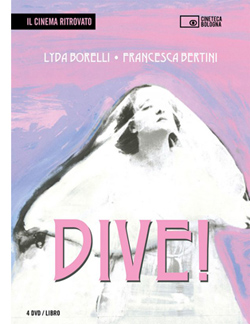
Ritrovato has always done well by its diva films, under the curatorship of Marianne Lewinsky. (They’ve just released a hot-pink box set of four classics.) In tribute to 1918 there were several star vehicles. I’ve already mentioned L’Avarazia (1918), an installment in a Francesca Bertini series devoted to the seven deadly sins.
Another high point was La Moglie di Claudio (1918), an exemplary tale of excess. When a movie starts by comparing its heroine to a spider, you know she means trouble. Cesarina (Pina Minichelli) two-times her husband, has an illegitimate child, flirts relentlessly with her husband’s protégé, collaborates with spies, and steals the plans to the cannon the husband has designed. She does it all in high style. As she dies, she falls clutching a window curtain.
In a fragment from Tosca (1918), we got a quick lesson in the illogical powers of cinematic composition. Tosca (Bertini again) visits her lover Mario in prison. Their furtive conversation is played out while the shadows of the guards come and go in the background. That’s a source of some suspense for us.
And for the couple as well. Instead of looking left at the offscreen window itself, which they could easily see, they–like us–turn to monitor the silhouettes.
It’s a nice variant on the background door or window so common in 1910s film.
Of all the surprises, the biggest for me was This Can’t Happen Here (aka High Tension, 1950), an Ingmar Bergman thriller. You read that right.
This Cold War intrigue shows spies from Liquidatsia (you read that right too) infiltrating a circle of refugees living in Sweden. The first half hour is soaked in noir aesthetics, with men in trenchcoats glimpsed in bursts of single-source lighting. The preposterous plot gives us a briefcase full of secret papers, attempted murder by hypodermic, torture scenes, and enemy agents acting impossibly suave at gunpoint. A cadre meets in a movie theatre playing a Disney cartoon, with Goofy’s offscreen gurgles punctuating an informer’s confession.
Bergman forbade screenings of the film, but Bologna was given the rare chance to reveal another side of his obsessions with brooding solitude and the pitfalls of love. Peter von Bagh’s illuminating essay included in the catalogue rightly emphasizes how in This Can’t Happen Here murder becomes the natural outcome of an unhappy marriage.
My visit was topped off by the charming Lucky to Be a Woman (1955) in the Mastroianni strand. Sophia Loren, looking like a million and a half bucks, plays a working girl accidentally turned into tabloid cheescake. Mastroianni is a louche photographer who can make her career. Bantering at breakneck speed, they thrust and parry for ninety-five minutes, all the while satirizing modeling, moviemaking, and the itchy palms of philandering middle-aged men. Mastroianni spins minutes of byplay out of an unlit cigarette, while La Loren plants herself like a statue in the foreground, facing us; if Marcello’s lucky, she may address him with a smoldering sidelong glance.
What’s not to like? After thirty-two years, Ritrovato’s magnificence is unflagging.
As usual, thanks must go to the core Ritrovato team: Festival Coordinator Guy Borlée (with appreciation for help with this entry) and the Directors (below). They and their corps of workers make this vastly complex celebration of cinema look easy. It’s actually a kind of miracle.
Ehsan Khoshbakht, Cecilia Cenciarelli, Mariann Lewinsky, and Gian Luca Farinelli.
Edgy color, trial testimony, and the world in unison: More movies at Ritrovato
The Woman under Oath (1919).
DB here:
Hard to keep up. Herewith, some highlights as Cinema Ritrovato, the Cannes of classic cinema, winds down.
Grease, still the word
Patricia Birch was a dancer with Martha Graham and Agnes De Mille. She went on to participate in West Side Story and to choreograph The Wild Party (1975) and both stage and film versions of A Little Night Music (1973, 1977). What brought her to Bologna was the restored version of Grease (1978). She choreographed that on both stage and screen, and she talked about it at a stimulating panel with Ehsan Khoshbakht and her son Peter Becker, of Criterion Films.
I had thought that Grease followed the vogue for boomer high-school nostalgia triggered by American Graffiti (1973), but it was actually ahead of that. The original Chicago version, reportedly raunchier than the New York version, premiered in 1971. It opened on Broadway in 1972 and ran until 1980. The film modified the stage show and added some songs.
Ms. Birch was a font of information about how she conceived the numbers. She says she thinks of dance as “timed behavior,” not set steps but patterns of motion. This idea allows her to choreograph actors who didn’t have dance training but who could “move well.” Peter ran a clip showing a passage of cascading hallway mischief that was as rhythmic as a dance number. This was one of several group-action scenes that Ms. Birch coordinated.
The Grease ensemble was huge, and Ms Birch organized it in a quasi-military way. There was a core of twenty proficient dancers, ten male-female couples. They supervised and coached the less skilled performers. For “We Go Together,” set in a carnival, each couple found business and steps for thirty other dancers.
“We Go Together” was the sort of big showstopper she called “Paramount numbers.” There were also the smaller-scaled “semi-Paramount numbers” and the intimate, character-driven “Internal numbers.” Ms Birch pointed out how the Paramounts built their power on unison steps and, eventually, massive kicklines. “People like to see the world in unison. Gets ’em every time.”
I learned a lot from Patricia Birch’s spirited discussion. Watch for a version of the panel to show up online.
Cutting edges
Film curator Olaf Müller set a new Ritrovato record: the shortest retrospective to date. Three films running less than twenty minutes introduced us to the oeuvre of Franz Schömbs.
Schömbs was a painter who became, according to Olaf, “probably the only avant-garde filmmaker of 1950s West Germany.” He started in the thirties by mounting paintings in rows, inviting viewers to walk along and sense the changes among them. After the war Schömbs tried to revive the experimentation of the Weimar period, principally through abstract films rich in color and design.
The films on the program were dense. Opuscula (1946-1952) consists of patches of color that slide to and fro “on top” of one another thanks to panning and tilting movements. The superimpositions create some striking visual hallucinations, as when blocks of white refuse to change color while other forms around them do. Die Geburt des Lichts (“The Birth of Light,” 1957, above), my favorite, transposes that constant movement to the patches of color themselves. These patches, as crisp as paper cutouts, have thrusting edges that keep slicing into the mates around them. Apparently Schömbs achieved the effect by applying paint to layers of glass and adjusting them frame by frame. Den Eisamen Allen (“To All the Lonely Ones,” 1962) uses what seemed to me traveling mattes, again enlivened by rich color.
Once more, Bologna proves a showcase for films that would otherwise go missing from film history.
Trial, with error
The courtroom drama was a mainstay of early twentieth-century theatre, but in 1915, playwright Elmer Rice gave it a twist. On Trial presented a murder trial by dramatizing the witnesses’ testimony in flashbacks. Rice offered another innovation as well: his flashbacks are non-chronological, starting with the most recent incident and reserving the climax for the earliest piece of action. Using the courtroom drama to play with time and viewpoint became a staple of American theatre and cinema.
Popular culture is a teeming mass of copies and near-copies–the switcheroo principle–so it didn’t take long for other storytellers to vary and complicate the trial format. One of the neatest examples was on display in Bologna. In the John Stahl silent drama The Woman under Oath (1919), flashbacks replay key actions according to what different witnesses know. We get no fewer than five flashbacks, some presenting incidents leading up to the crime, others recounting the murder itself. The later ones fill gaps in the earlier ones and culminate in a full, accurate version of the killing.
Proving once more that 1910s cinema can be pretty intricate, the same pieces of action get redeployed in different witnesses’ testimony. Sometimes the camera setups are varied to differentiate the versions.
At other moments, nearly identical framings mislead us by concealing important information. The young man accused of the murder is shown near the victim in three pieces of testimony, with the first two instances being essentially identical but the last presentation providing different information. (To avoid a spoiler, I don’t show the portion of the third shot that yields that information.)
The Woman under Oath shows a sophisticated understanding of how framing can conceal information without our being aware of it. And in retrospect what seems a colossal coincidence during the first presentation of the killing turns out to be a perfectly motivated key to the solution.
Switcheroos on the trial-testimony format showed up in other Ritrovato films. By 1928, the idea of conflicting testimony enacted in “lying” flashbacks was conventional enough to be parodied in René Clair’s Les Deux timides (“Two Timid Souls”). Here the disparities are wildly comic, accentuated by split-screen and freeze frame. Albert Valentin’s La Vie de Plaisir (1944), made under the German occupation of France, is an elegant social comedy pitting a couple against one another in divorce court. The spiteful witnesses offer testimony damning the husband only to get refuted in replays that reveal extra information. Throughout world cinema, the flashback trial film seems to have been one way oblique narrative strategies were made understandable for a wide audience.
Thanks as ever to Guy Borlée for assistance, and to the Ritrovato programmers for supplying so many treats. Thanks also to Kelley Conway for discussion of the courtroom movies. We should also be grateful to the BFI for providing Bologna with the copy of The Woman under Oath.
One rough precedent for Rice’s play is Browning’s verse novel The Ring and the Book (1868-1869). The lingering awareness of Rice’s play is evident in Variety‘s review of The Woman under Oath, which the critic labeled “a sort of ‘On Trial’ affair” (20 June 1919, 52). In the same year there was an interesting parallel in the flashback testimony in Dreyer’s The President (1919).
You can find more about the switcheroo premise in my Reinventing Hollywood, which also discusses the trial format. For more on flashbacks see this entry. A series of entries on complex 1910s cinema start with this one.
P.S. 3 July 2018: Thanks to Peter Becker for a correction.
Les Deux timides (1928).












